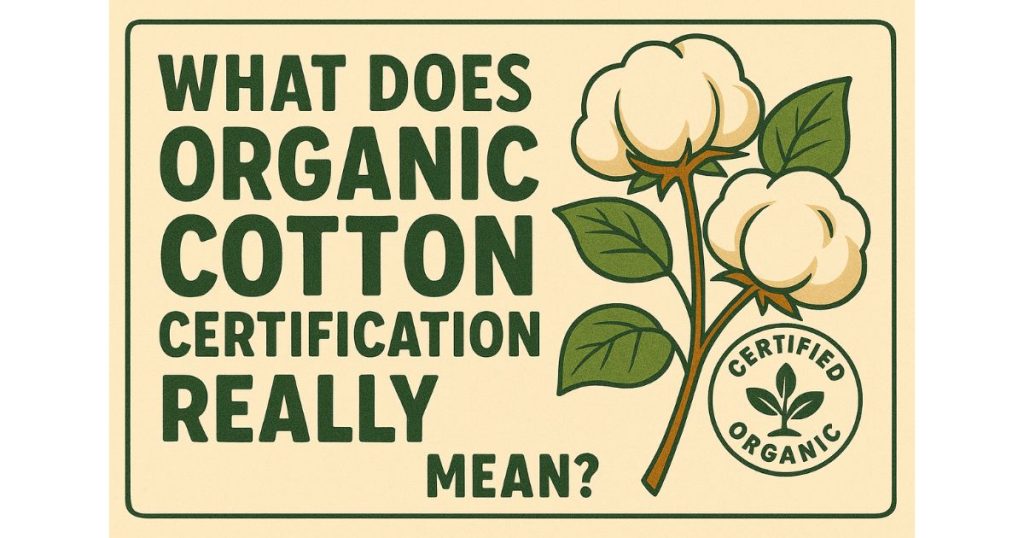Organic cotton certification isn’t just a label—it’s a verified commitment to sustainability, ethical farming, and transparency across the textile supply chain. This guide explains the standards, systems, and sustainability impact of certified organic cotton, so you can shop smarter and support better practices.
What Is Organic Cotton Certification?
Organic cotton certification is a formal verification that cotton has been grown and processed according to strict environmental and social criteria. It ensures that the cotton is:
- Grown without synthetic pesticides, chemical fertilizers, or genetically modified seeds
- Harvested in a way that protects soil health and biodiversity
- Processed using non-toxic substances
- Verified through third-party audits, documentation, and traceability
Certification transforms marketing claims into measurable, enforceable standards.
Why Organic Certification Matters in Sustainable Fashion
Conventional cotton is one of the most pesticide-heavy crops in the world. Organic certification addresses that harm by enforcing better practices across key sustainability areas:
- Pesticide-free farming improves soil and water health
- Fair labor standards promote worker safety and ethical conditions
- Transparent supply chains reduce greenwashing
- Non-GMO crop integrity preserves seed biodiversity
According to Textile Exchange’s 2023 report, certified organic cotton farming results in 46% fewer greenhouse gas emissions than conventional methods.
🟢 Related: Sustainable Fashion Guide
Who Certifies Organic Cotton?
Not all certifications are equal. These are the most trusted and relevant:
1. Global Organic Textile Standard (GOTS)
- Covers the entire lifecycle: farming, labor, and processing
- Requires 70–95% organic fiber content
- Prohibits chlorine bleach and toxic chemicals
- Enforces wastewater treatment and fair labor practices
🔗 Visit GOTS
2. USDA Organic
- Ensures organic growing practices in the U.S.
- No GMOs, synthetic pesticides, or soil-harming inputs
- Does not cover processing, labor, or supply chain transparency
🔗 Visit USDA Organic
3. OEKO-TEX Made in Green
- Focuses on safety in dyeing and manufacturing
- Often used in combination with GOTS or OCS
- Doesn’t cover farming methods
4. Organic Content Standard (OCS)
- Verifies presence of organic material
- Does not audit chemicals or labor conditions
🔗 Visit Textile Exchange
Tip: Always verify the certifying body. “Organic cotton” means little without third-party proof.
What Are the Certification Requirements?
| Standard | Description |
|---|---|
| No Pesticides | Synthetic pesticides and herbicides are banned |
| Non-GMO Seeds | Only non-genetically modified seeds allowed |
| Soil Health | Crop rotation, composting, and cover crops required |
| Fair Labor | Third-party audits ensure no child labor or exploitation |
| Traceability | Cotton is tracked from farm to finished product |
| Safe Processing | Limits on toxic dyes, heavy metals, and residues |
Each standard is enforced through audits, farm visits, documentation, and testing.
Is Organic Cotton Really More Sustainable?
Yes—and not just in theory. Certified organic cotton delivers clear environmental and social benefits:
- Waterways are cleaner due to the absence of synthetic chemicals
- Pollinators and soil life thrive in biodiverse organic systems
- Farmers are safer, not exposed to harmful agrochemicals
- Carbon emissions are lower due to fewer fossil fuel–based inputs
Expert Insight
“Organic cotton certification gives consumers a way to directly support regenerative agriculture. It’s about more than fiber—it’s a systems change.”
— Lisa Braun, Sustainability Auditor, GOTS
How to Identify Certified Organic Cotton
Follow these simple steps to confirm that what you’re buying is the real thing:
- Look for GOTS Certified, USDA Organic, or OCS 100 on the label
- Check the certification number in the certifier’s online database
- Avoid vague claims like “natural cotton” without documentation
- Support transparent brands that share audits and traceability reports
Recommended Brands That Use Certified Organic Cotton
| Brand | Certification | Category |
|---|---|---|
| Pact | GOTS | Everyday basics |
| Coyuchi | GOTS | Bedding & bath |
| Organic Basics | GOTS | Intimates & loungewear |
| MATE the Label | GOTS | Women’s clothing |
| Patagonia | GOTS, OCS | Outdoor wear |
These brands meet strict sustainability and ethics criteria. Some links may earn affiliate commissions to support WholePeople at no extra cost.
🛍️ Related: Best Online Thrift Stores
What is GOTS certified organic cotton?
GOTS certified cotton meets strict standards for organic farming, ethical labor, and low-impact processing. It’s the gold standard in organic textiles.
How is USDA Organic different from GOTS?
USDA Organic certifies farming practices only. GOTS includes farming, labor conditions, and post-harvest processing.
Is OCS certification as strong as GOTS?
No. OCS verifies the presence of organic material but does not regulate chemical use, labor standards, or environmental impact in manufacturing.
Why does organic cotton cost more?
Organic farming avoids subsidies, uses labor-intensive methods, and incurs certification costs—all of which can raise retail prices.
Is all organic cotton better for the planet?
Only when it’s certified. “Organic” without verification can be a greenwashing tactic. Trust only third-party–certified cotton.
Can I verify certification myself?
Yes. Most certifiers offer online databases where you can check certification numbers printed on the product label.

